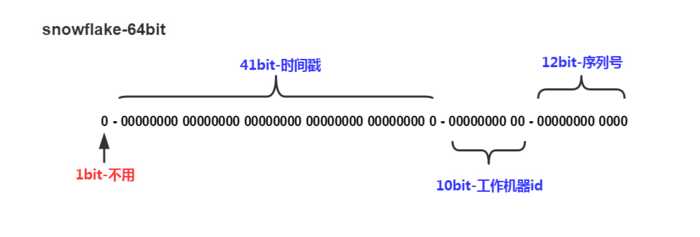标签:init ringbuf eject 调用 定义 定时任务 ola f11 flags
https://github.com/baidu/uid-generator
uid-generator是基于Twitter开源的snowflake算法实现的。
snowflake将long的64位分为了3部分,时间戳、工作机器id和序列号,位数分配如下。

其中,时间戳部分的时间单位一般为毫秒。也就是说1台工作机器1毫秒可产生4096个id(2的12次方)。
与原始的snowflake算法不同,uid-generator支持自定义时间戳、工作机器id和序列号等各部分的位数,以应用于不同场景。默认分配方式如下。

sign(1bit)
固定1bit符号标识,即生成的UID为正数。
delta seconds (28 bits)
当前时间,相对于时间基点"2016-05-20"的增量值,单位:秒,最多可支持约8.7年(注意:1. 这里的单位是秒,而不是毫秒! 2.注意这里的用词,是“最多”可支持8.7年,为什么是“最多”,后面会讲)
worker id (22 bits)
机器id,最多可支持约420w次机器启动。内置实现为在启动时由数据库分配,默认分配策略为用后即弃,后续可提供复用策略。
sequence (13 bits)
每秒下的并发序列,13 bits可支持每秒8192个并发。(注意下这个地方,默认支持qps最大为8192个)
DefaultUidGenerator的产生id的方法与基本上就是常见的snowflake算法实现,仅有一些不同,如以秒为为单位而不是毫秒。
DefaultUidGenerator的产生id的方法如下。
protected synchronized long nextId() { long currentSecond = getCurrentSecond(); // Clock moved backwards, refuse to generate uid if (currentSecond < lastSecond) { long refusedSeconds = lastSecond - currentSecond; throw new UidGenerateException("Clock moved backwards. Refusing for %d seconds", refusedSeconds); } // At the same second, increase sequence if (currentSecond == lastSecond) { sequence = (sequence + 1) & bitsAllocator.getMaxSequence(); // Exceed the max sequence, we wait the next second to generate uid if (sequence == 0) { currentSecond = getNextSecond(lastSecond); } // At the different second, sequence restart from zero } else { sequence = 0L; } lastSecond = currentSecond; // Allocate bits for UID return bitsAllocator.allocate(currentSecond - epochSeconds, workerId, sequence); }
CachedUidGenerator支持缓存生成的id。
关于CachedUidGenerator,文档上是这样介绍的。
使用RingBuffer缓存生成的id。RingBuffer是个环形数组,默认大小为8192个,里面缓存着生成的id。
会从ringbuffer中拿一个id,支持并发获取
RingBuffer填充时机
程序启动时,将RingBuffer填充满,缓存着8192个id
在调用getUID()获取id时,检测到RingBuffer中的剩余id个数小于总个数的50%,将RingBuffer填充满,使其缓存8192个id
定时填充(可配置是否使用以及定时任务的周期)

因为delta seconds部分是以秒为单位的,所以1个worker 1秒内最多生成的id书为8192个(2的13次方)。
从上可知,支持的最大qps为8192,所以通过缓存id来提高吞吐量。
为什么叫借助未来时间?
因为每秒最多生成8192个id,当1秒获取id数多于8192时,RingBuffer中的id很快消耗完毕,在填充RingBuffer时,生成的id的delta seconds 部分只能使用未来的时间。
(因为使用了未来的时间来生成id,所以上面说的是,【最多】可支持约8.7年)
@Override public long getUID() { try { return ringBuffer.take(); } catch (Exception e) { LOGGER.error("Generate unique id exception. ", e); throw new UidGenerateException(e); } }
(注意:这里的RingBuffer不是Disruptor框架中的RingBuffer,但是借助了很多Disruptor中RingBuffer的设计思想,比如使用缓存行填充解决伪共享问题)
RingBuffer为环形数组,默认容量为sequence可容纳的最大值(8192个),可以通过boostPower参数设置大小。
tail指针、Cursor指针用于环形数组上读写slot:
Tail指针
表示Producer生产的最大序号(此序号从0开始,持续递增)。Tail不能超过Cursor,即生产者不能覆盖未消费的slot。当Tail已赶上curosr,此时可通过rejectedPutBufferHandler指定PutRejectPolicy
Cursor指针
表示Consumer消费到的最小序号(序号序列与Producer序列相同)。Cursor不能超过Tail,即不能消费未生产的slot。当Cursor已赶上tail,此时可通过rejectedTakeBufferHandler指定TakeRejectPolicy
CachedUidGenerator采用了双RingBuffer,Uid-RingBuffer用于存储Uid、Flag-RingBuffer用于存储Uid状态(是否可填充、是否可消费)
由于数组元素在内存中是连续分配的,可最大程度利用CPU cache以提升性能。但同时会带来「伪共享」FalseSharing问题,为此在Tail、Cursor指针、Flag-RingBuffer中采用了CacheLine 补齐方式。

public class RingBuffer { private static final Logger LOGGER = LoggerFactory.getLogger(RingBuffer.class); /** Constants */ private static final int START_POINT = -1; private static final long CAN_PUT_FLAG = 0L; //用于标记当前slot的状态,表示可以put一个id进去 private static final long CAN_TAKE_FLAG = 1L; //用于标记当前slot的状态,表示可以take一个id public static final int DEFAULT_PADDING_PERCENT = 50; //用于控制何时填充slots的默认阈值:当剩余的可用的slot的个数,小于bufferSize的50%时,需要生成id将slots填满 /** The size of RingBuffer‘s slots, each slot hold a UID */ private final int bufferSize; //slots的大小,默认为sequence可容量的最大值,即8192个 private final long indexMask; private final long[] slots; //slots用于缓存已经生成的id private final PaddedAtomicLong[] flags; //flags用于存储id的状态(是否可填充、是否可消费) /** Tail: last position sequence to produce */ //Tail指针 //表示Producer生产的最大序号(此序号从0开始,持续递增)。Tail不能超过Cursor,即生产者不能覆盖未消费的slot。当Tail已赶上curosr,此时可通过rejectedPutBufferHandler指定PutRejectPolicy private final AtomicLong tail = new PaddedAtomicLong(START_POINT); // /** Cursor: current position sequence to consume */ //表示Consumer消费到的最小序号(序号序列与Producer序列相同)。Cursor不能超过Tail,即不能消费未生产的slot。当Cursor已赶上tail,此时可通过rejectedTakeBufferHandler指定TakeRejectPolicy private final AtomicLong cursor = new PaddedAtomicLong(START_POINT); /** Threshold for trigger padding buffer*/ private final int paddingThreshold; //用于控制何时填充slots的阈值 /** Reject put/take buffer handle policy */ //当slots满了,无法继续put时的处理策略。默认实现:无法进行put,仅记录日志 private RejectedPutBufferHandler rejectedPutHandler = this::discardPutBuffer; //当slots空了,无法继续take时的处理策略。默认实现:仅抛出异常 private RejectedTakeBufferHandler rejectedTakeHandler = this::exceptionRejectedTakeBuffer; /** Executor of padding buffer */ //用于运行【生成id将slots填满】任务 private BufferPaddingExecutor bufferPaddingExecutor;
RingBuffer填充时机
程序启动时,将RingBuffer填充满,缓存着8192个id
在调用getUID()获取id时,检测到RingBuffer中的剩余id个数小于总个数的50%,将RingBuffer填充满,使其缓存8192个id
定时填充(可配置是否使用以及定时任务的周期)
填充RingBuffer
/** * Padding buffer fill the slots until to catch the cursor */ public void paddingBuffer() { LOGGER.info("Ready to padding buffer lastSecond:{}. {}", lastSecond.get(), ringBuffer); // is still running if (!running.compareAndSet(false, true)) { LOGGER.info("Padding buffer is still running. {}", ringBuffer); return; } // fill the rest slots until to catch the cursor boolean isFullRingBuffer = false; while (!isFullRingBuffer) { //获取生成的id,放到RingBuffer中。 List<Long> uidList = uidProvider.provide(lastSecond.incrementAndGet()); for (Long uid : uidList) { isFullRingBuffer = !ringBuffer.put(uid); if (isFullRingBuffer) { break; } } } // not running now running.compareAndSet(true, false); LOGGER.info("End to padding buffer lastSecond:{}. {}", lastSecond.get(), ringBuffer); }
生成id(上面代码中的uidProvider.provide调用的就是这个方法)
/** * Get the UIDs in the same specified second under the max sequence * * @param currentSecond * @return UID list, size of {@link BitsAllocator#getMaxSequence()} + 1 */ protected List<Long> nextIdsForOneSecond(long currentSecond) { // Initialize result list size of (max sequence + 1) int listSize = (int) bitsAllocator.getMaxSequence() + 1; List<Long> uidList = new ArrayList<>(listSize); // Allocate the first sequence of the second, the others can be calculated with the offset //这里的实现很取巧 //因为1秒内生成的id是连续的,所以利用第1个id来生成后面的id,而不用频繁调用snowflake算法 long firstSeqUid = bitsAllocator.allocate(currentSecond - epochSeconds, workerId, 0L); for (int offset = 0; offset < listSize; offset++) { uidList.add(firstSeqUid + offset); } return uidList; }
填充缓存行解决“伪共享”
关于伪共享,可以参考这篇文章《伪共享(false sharing),并发编程无声的性能杀手》
//数组在物理上是连续存储的,flags数组用来保存id的状态(是否可消费、是否可填充),在填入id和消费id时,会被频繁的修改。 //如果不进行缓存行填充,会导致频繁的缓存行失效,直接从内存中读数据。 private final PaddedAtomicLong[] flags; //tail和cursor都使用缓存行填充,是为了避免tail和cursor落到同一个缓存行上。 /** Tail: last position sequence to produce */ private final AtomicLong tail = new PaddedAtomicLong(START_POINT); /** Cursor: current position sequence to consume */ private final AtomicLong cursor = new PaddedAtomicLong(START_POINT)
/** * Represents a padded {@link AtomicLong} to prevent the FalseSharing problem<p> * * The CPU cache line commonly be 64 bytes, here is a sample of cache line after padding:<br> * 64 bytes = 8 bytes (object reference) + 6 * 8 bytes (padded long) + 8 bytes (a long value) * @author yutianbao */ public class PaddedAtomicLong extends AtomicLong { private static final long serialVersionUID = -3415778863941386253L; /** Padded 6 long (48 bytes) */ public volatile long p1, p2, p3, p4, p5, p6 = 7L; /** * Constructors from {@link AtomicLong} */ public PaddedAtomicLong() { super(); } public PaddedAtomicLong(long initialValue) { super(initialValue); } /** * To prevent GC optimizations for cleaning unused padded references */ public long sumPaddingToPreventOptimization() { return p1 + p2 + p3 + p4 + p5 + p6; } }
可以参考下面文章
一个Java对象到底占用多大内存?https://www.cnblogs.com/magialmoon/p/3757767.html
写Java也得了解CPU--伪共享 https://www.cnblogs.com/techyc/p/3625701.html
标签:init ringbuf eject 调用 定义 定时任务 ola f11 flags
原文地址:https://www.cnblogs.com/yeyang/p/10226284.html